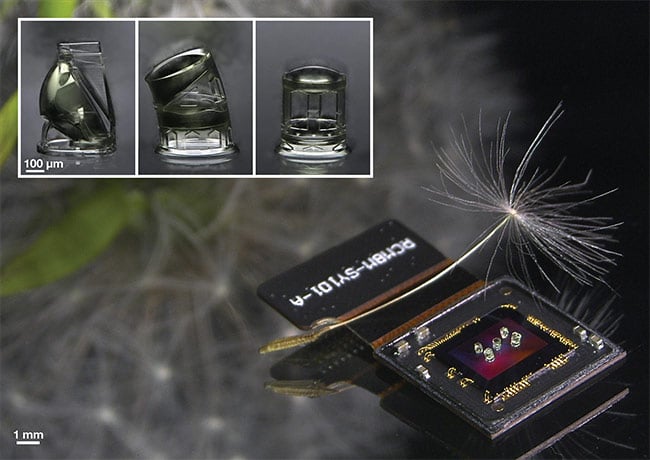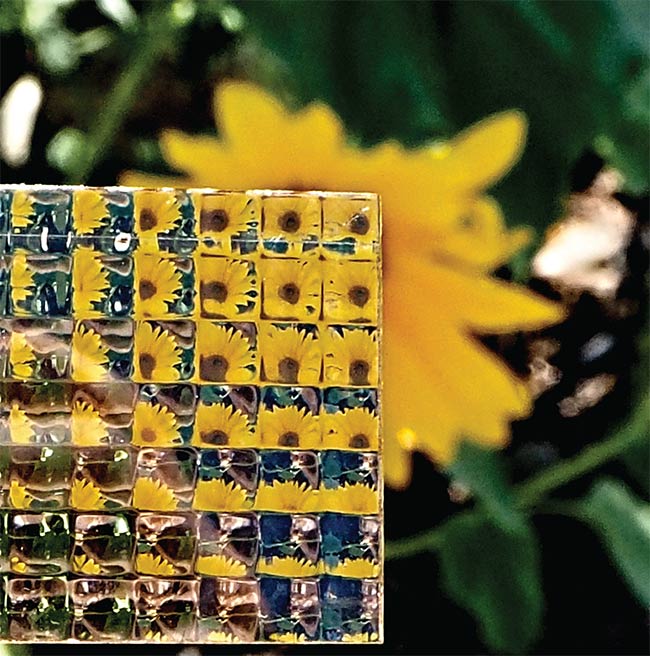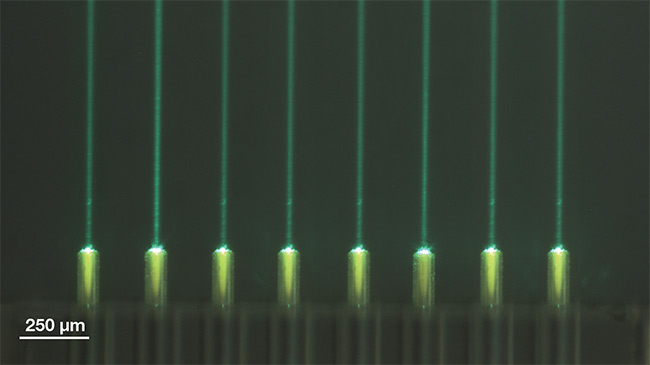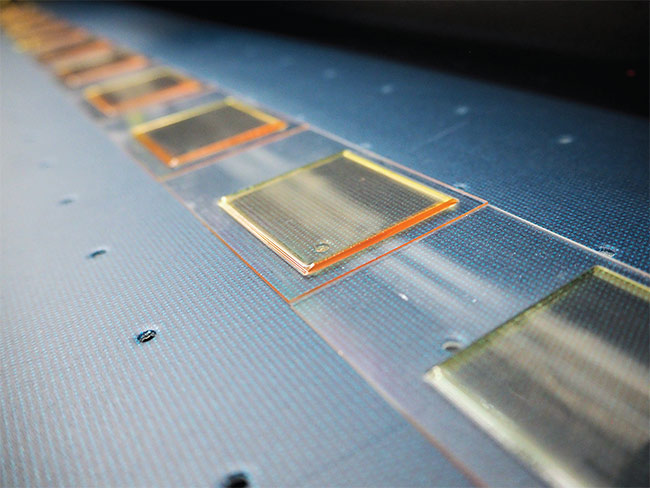Additive manufacturing technology enables the fabrication of innovative, multifunctional lenses and components that promise to simplify and shrink conventional optical systems.
HANK HOGAN, CONTRIBUTING EDITOR
Emerging 3D printing
technology is transforming
once-impossible designs
of optical components into
optimized elements that can
improve medical instruments,
research tools, communications
systems, and consumer devices.
In 3D printing, an additive process
prints an entire optical component one
tiny particle at a time, enabling designs
that combine multiple functions in a
single lens or pre-align a system by
creating optics, mounts, and baffles
together. The new optical designs can
reduce a product’s footprint, improve
technical performance, and facilitate
commercial scale-up.
Australian and German researchers
recently 3D-printed a single 330-μmdiameter
lens, for example, that simultaneously
met high- and low-numerical
aperture requirements with a lens-in-lens
design1. Impossible to fabricate conventionally,
the lens enabled both fluorescence
and optical coherence tomography
with a 0.52-mm-diameter probe. In their
paper, the researchers reported a better
than 10× improvement in fluorescence
contrast compared to a more traditional
fiber-optic design.
“3D printing actually shines in high miniaturization,
impossible parts that
you cannot do with other methods and
also has very nice alignment possibilities,”
said Simon Thiele, CTO at 3Dprinting
company Printoptix and one of
the authors of the paper.
Being able to print an optic along with
its mount and other elements saves time
and minimizes installation errors. Plus,
being able to adjust an optic’s shape and
properties on a small scale allows one
lens to do the work of several. Medical
applications, cellphones, and soldiers in
the field could benefit. 3D printing can
also reduce the amount of time needed to
prototype an optical design from months
to days, a significant time savings.
But 3D printing of optical components
also faces hurdles, such as limited availability
of optically relevant materials,
slow manufacturing speed, and high cost,
especially for large volumes.
Additive processing options for optics
Industry and researchers are addressing
these issues with an array of 3D-printing
techniques. Professor Tomasz Tkaczyk of
Rice University and his colleagues
reviewed the capabilities and performance
levels of fused deposition modeling,
inkjet printing, stereolithography, and
two-photon polymerization2.

An integrated 3D-printed 1.1-mm-diameter lens
system with a distortion-free 90° field of view for
microcamera applications. (Match head used for
size comparison.) Made on an optimized Nanoscribe
two-photon polymerization (2PP) 3D printer. Courtesy of Printoptix GmbH.
Fused deposition modeling heats a
material, extrudes it through a nozzle, and
deposits it layer by layer. The researchers
reported that the method creates the largest
volume structures in the shortest time,
but it does so with a feature size of a few
hundred nanometers and a surface roughness
of about 1000 nm.
In comparison, molded optics have a
roughness of about 10 nm. Polished optics
are even smoother, with a surface roughness
of about 1 nm. Surface roughness
and feature size are important because
they determine optical performance. They
need to be comparable to or below the
wavelength of interest for feature size,
and well below it for roughness.
Two-photon polymerization (2PP)
uses a pulsed laser to induce a multiphoton
process that occurs only in a small
focal region, and the photons alter the
material. Moving the focal point in three
dimensions creates structures, layer by
layer. 2PP printed the finest features, the
researchers said, resulting in feature sizes
of <0.1 μm and a surface roughness of 10
nm. However, the technique was the slowest
to make a large-volume object. Inkjet
printing (which deposits ink drops for 3D
printing) and stereolithography (which
3D-prints using photolithography) fell in
between the other techniques in terms of
speed, feature size, and surface roughness.
Inkjet printing allowed for smaller
and smoother features.

An image sensor that includes a complex lens
system is 3D-printed directly onto an imaging
sensor matrix. Courtesy of Andrea Toulouse/Nils Fahrbach.
Various technologies are in commercial
production. Luxexcel uses inkjet printing
followed by UV curing of a polymer to
make 3D-printed lenses, for instance. The
company won a 2022 Prism Award for a
solution that builds smart eyewear with
prescription lenses.
Multi-index elements
Startup NanoVox, which is transitioning
its name to Vadient Optics, also uses inkjet
3D printing, but it does so with a twist
— offering volumetric index of refraction
gradient optics (VIRGO).
“We’re not just printing polymers as
they are,” said James Field, the company’s
vice president of business development.
“We’re using high and low index of
refraction monomers that are infused with
nanoparticles that sculpt the light in the
bulk [material] instead of having to do it
with surface curvature.”
NanoVox achieves this optical performance
by doping the ink with nanoparticles
smaller than 10 nm. The
company’s pilot production machine,
a third-generation system, can have as
many as eight printheads, each loaded
with a different ink formulation. The
machine adjusts ink dispensing to create
optics with changes in index of refraction
from one small volume to the next.
The technology can fabricate a single flat
lens that outperforms a combination of
multiple curved ones.
The potential market for this technique
is large, according to Field. Cameras in
phones use a stack of eight or nine lenses,
for instance, to correct for aberrations and
distortions. Using NanoVox’s technology,
the lens count could drop to four, which
would save phone-makers money and
possibly space.
NanoVox is making its own machines
while developing the nanoparticle-infused
inks. The company will be a service
bureau, Field said. Thus, it will make
products for others and not sell its own.
Another 3D-printing startup is Printoptix,
which uses 2PP systems from
printmaker Nanoscribe. Printoptix is
currently a service bureau that sells
printing and prototyping services. It is
transitioning to selling its own parts and
eventually to licensing its processes,
according to managing director Nils
Fahrbach. He said the company’s optimizations
accelerate optics processing.
This increase in throughput could be
crucial for some applications. The distance
between the eyes varies from person
to person, for example, and Fahrbach
said matching this spacing is critical
for high AR/VR performance in smart
glasses or goggles. 3D printing offers a
way to achieve personalization quickly
and, eventually, perhaps at no extra cost.
“You just hit a button and the optics are
printed individually to the customer at
the same cost as any other optic,” he said
of such on-the-spot customized AR/VR
display components.
Sofía Rodríguez, product marketing
manager for Nanoscribe, said the company’s
latest 3D printer and polymers offer
alignment accuracies down to 100 nm.
This enables the printing of freeform optical
elements directly onto optical fiber,
fiber arrays, and photonic chips.
Expanding material availability
In June 2021, Nanoscribe announced the
release of a photoresin of fused silica
glass that the company developed with
Glassomer. This material allows 3D printing
of glass microstructures, giving users
a wider range of materials.

Modified inkjet technology is enabling
3D-printed planar lens arrays, such as these
10-mm f/4 gradient index (GRIN) lenses. Current
systems can deposit various monomer ink
formulations, using up to eight printheads to
fabricate flat lenses that meet or exceed the
performance of curved optics. Courtesy of NanoVox.
Other researchers are also exploring 3D
printing using glass. For example, Rongguang
Liang, a professor at the University
of Arizona, co-authored an Advanced
Science paper this year that introduced a
liquid silica resin used in 2PP printing3.
He said some polymers yellow with
age, a consequence of being UV light
curable. Polymers also absorb water,
undergo large expansion and contraction
with temperature changes, and are soft
compared to glass.
“The optical properties are not as good
as glass,” Liang said.
Using a custom-made fused silica resin
and a process designed for it, he and his
colleagues 3D-printed lenses, a lenslet
array, gratings, and freeform optics.
They demonstrated the resulting optics’
imaging performance using a standard
resolution target, a University of Arizona
logo, and biological samples.
Having a wide variety of materials
is important for further advancements
in 3D printing, Printoptix’s Fahrbach
said. One of the strengths of 3D printing
is the ability to align the optics, which
is easy to achieve when printing optics,
baffles, and a mount at the same time.
However, if the optic is transmissive,
then all of the components — including
the baffles — are transparent. As a
result, post-processing is necessary,
which drives up cost and lowers the
overall component throughput. Being
able to 3D-print dissimilar materials
could overcome this issue and expand
the applications.

A lensed fiber array, 3D-printed using
Nanoscribe’s 2PP technology, collimates green
light into parallel beams. A sample from the
research project MiLiQuant. Courtesy of Nanoscribe.
The varying refractive indices that are
possible when using NanoVox’s process
are one way to achieve this goal of
printing different materials. Currently,
the change in refractive index is only
0.15, but Field said work is underway to
expand and perhaps double this range.
He also said the company is working on
a glass 3D-printing material and process,
but they are not likely to be available for
years.
Improving cost and cycle time
To accomplish widespread commercial
success, 3D printing must also cost
less and/or achieve a faster throughput.
Nanoscribe is addressing this challenge,
in part, by piloting alternative replication
strategies. For example, 3D printing
could be used to create an initial component
that would then be reproduced
in mass quantities using nanoimprint
lithography and injection molding,
Rodriguez said.
The company Addoptics uses a similar
strategy. Marketing manager Meghan
Pace said Addoptics 3D-prints a mold
that is used to make the optics. Importantly,
the components that come out
of the mold require little to no postprocessing.
This approach reduces the
cycle time for a prototype from as much
as 18 weeks to six days while also
producing a mold suitable for volume
production.
Inkjet printing, by its nature, can scale
to higher volume production, said Jyrki
Saarinen, a professor at the University of
Eastern Finland. He and his team have
demonstrated and are refining a multimaterial
inkjet 3D-printing process for
freeform optics.

A dozen planar Alvarez lenses are produced on a NanoVox pilot line with 1-μm drop precision. The line can print lenses measuring in size from 500 μm to 5 in. Scaling volume will require advancements in inkjet equipment, printing materials, and processes. Courtesy of NanoVox.
“The largest printers have tens of
printheads attached next to each other,”
Saarinen said. “Printing 1 sq cm or
1 sq m, one component versus hundreds
of components side by side, takes the
same time.”
NanoVox’s third-generation VIRGO
pilot production system can churn out
15,000 eyeglass lenses or 300,000
mobile camera lenses per month. This
is hundreds of times the throughput of
the company’s research system but
still small compared to the hundreds of
millions of smartphones produced each
month.
Further throughput gains require
equipment, materials, and process
changes. NanoVox’s Field said process
throughput and product cost are the most
pressing challenges confronting 3D printing
of optics.
“They’re just trying to get to the point
where they can manufacture it at a cost
that makes sense to the buyer,” he said.
References
1. J. Li et al. (2022). 3D-printed micro lensin-
lens for in vivo multimodal microendoscopy.
Small, Vol. 18, p. 2107032,
www.doi.org/10.1002/smll.202107032.
2. G. Berglund et al. (2022). Additive
manufacturing for the development of
optical/photonic systems and components.
Optica, Vol. 9, No. 6, pp. 623-638,
www.doi.org/10.1364/optica.451642.
3. Z. Hong et al. (2022). High-precision
printing of complex glass imaging
optics with precondensed liquid silica
resin. Adv Sci, Vol. 9, p. 2105595,
www.doi.org/10.1002/advs.202105595.